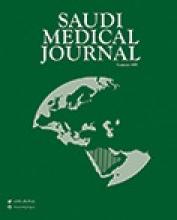Abstract
OBJECTIVE: To study the outcome of patients with thoracolumbar fracture treated surgically or conservatively at the Armed Forces Hospital, Riyadh, Kingdom of Saudi Arabia, between the year 1989 through to 1999.
METHODS: The medical and surgical record of all patients diagnosed as having thoracolumbar fracture (thoracic 10-lumbar 12) between the years 1989 to 1999 were reviewed. The parameter studies included the personal patient data, type of fracture, mechanism and cause of injury and neurological affection. For the outcome, the method of treatment and recovery from neurological deficit, return to pre-injury activity and work as well as complications were noted.
RESULTS: One hundred patients were treated for thoracolumbar fracture. Seventy two percent were related to motor vehicle accident, 37% had neurological deficit, 19 of them had complete lesion. Thoracic 12 Lumbar 1 constituted 63% of injury level. Forty-four patients were treated surgically whereas 56 had conservative treatment. At follow up, 17 patients had complete recovery from neurological deficit while 6 had partial recovery and 14 had no recovery at all. No major complication has occurred due to method of treatment in both groups.
CONCLUSION: Treatment of thoracolumbar fracture was carried out using both surgical and conservative methods. In our view, surgical treatment is indicated in cases of instability or removal of retropulsive fragment if there is neurological deficit or to correct deformity. For other cases conservative treatment was selected and gave satisfactory results.
- Copyright: © Saudi Medical Journal
This is an open-access article distributed under the terms of the Creative Commons Attribution-Noncommercial-Share Alike 3.0 Unported, which permits unrestricted use, distribution, and reproduction in any medium, provided the original work is properly cited.






